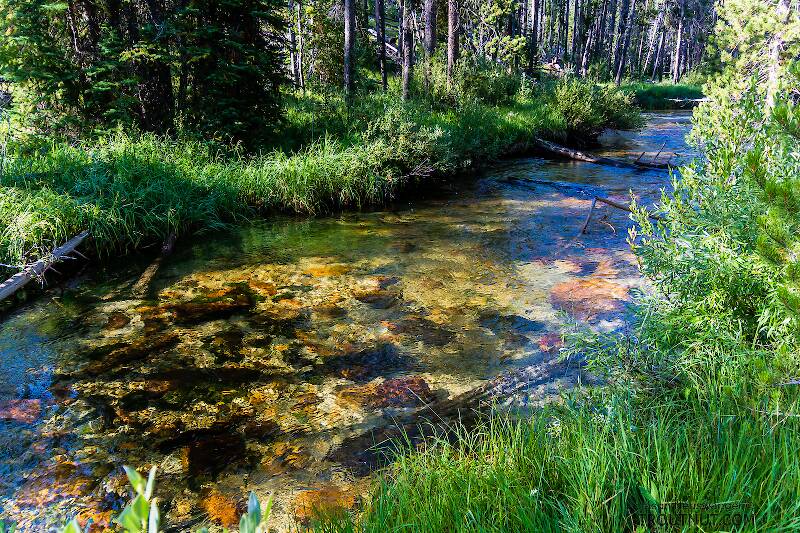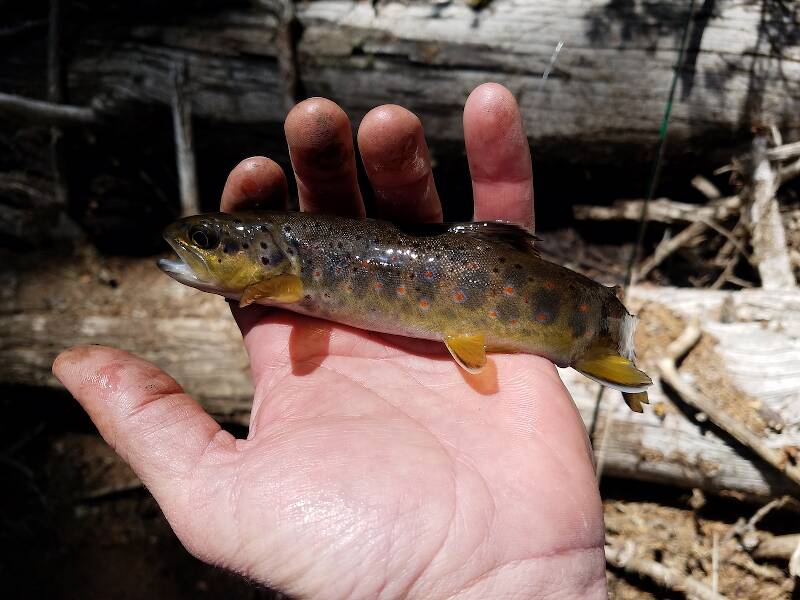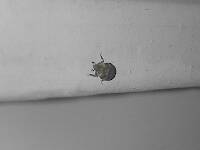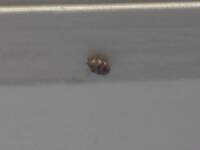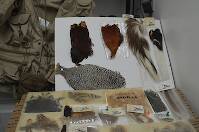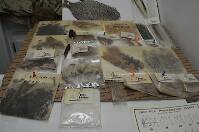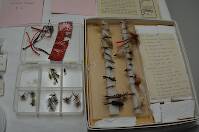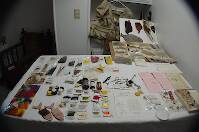
Blue-winged Olives
Baetis
Tiny Baetis mayflies are perhaps the most commonly encountered and imitated by anglers on all American trout streams due to their great abundance, widespread distribution, and trout-friendly emergence habits.
Featured on the forum

This is a striking caddis larva with an interesting color pattern on the head. Here are some characteristics I was able to see under the microscope, but could not easily expose for a picture:
- The prosternal horn is present.
- The mandible is clearly toothed, not formed into a uniform scraper blade.
- The seems to be only 2 major setae on the ventral edge of the hind femur.
- Chloride epithelia seem to be absent from the dorsal side of any abdominal segments.
Based on these characteristics and the ones more easily visible from the pictures, this seems to be Grammotaulius. The key's description of the case is spot-on: "Case cylindrical, made of longitudinally arranged sedge or similar leaves," as is the description of the markings on the head, "Dorsum of head light brownish yellow with numerous discrete, small, dark spots." The spot pattern on the head is a very good match to figure 19.312 of Merritt R.W., Cummins, K.W., and Berg, M.B. (2019). The species ID is based on Grammotaulius betteni being the only species of this genus known in Washington state.
- The prosternal horn is present.
- The mandible is clearly toothed, not formed into a uniform scraper blade.
- The seems to be only 2 major setae on the ventral edge of the hind femur.
- Chloride epithelia seem to be absent from the dorsal side of any abdominal segments.
Based on these characteristics and the ones more easily visible from the pictures, this seems to be Grammotaulius. The key's description of the case is spot-on: "Case cylindrical, made of longitudinally arranged sedge or similar leaves," as is the description of the markings on the head, "Dorsum of head light brownish yellow with numerous discrete, small, dark spots." The spot pattern on the head is a very good match to figure 19.312 of Merritt R.W., Cummins, K.W., and Berg, M.B. (2019). The species ID is based on Grammotaulius betteni being the only species of this genus known in Washington state.

Troutnut is a project started in 2003 by salmonid ecologist Jason "Troutnut" Neuswanger to help anglers and
fly tyers unabashedly embrace the entomological side of the sport. Learn more about Troutnut or
support the project for an enhanced experience here.
Red_green_h on Nov 16, 2020November 16th, 2020, 8:31 am EST
Anybody know what mop flies are and are they really flies or just lures? Same thing with Pistol Pete's, are they considered streamers or just lures? I've fished them with success. Just wondering what a purist would think about these "flies."
Wbranch on Nov 16, 2020November 16th, 2020, 12:08 pm EST
Mop flies are typically considered nymphs and it appears more specifically caddis larvae or pupa. But I guess you could be creative and tie other nymphs with them too. The material comes from floor mops. Personally, since I am primarily a dry fly guy I wouldn't have any in my box for trout. But I guess I might use them for steelhead.
Catskill fly fisher for fifty-five years.
Troutnut on Nov 16, 2020November 16th, 2020, 4:03 pm EST
I haven't fished mop flies, but I just got materials to tie up a batch and I am looking forward to giving them a try.
I can't imagine why anyone would oppose them on purist grounds, because their profile and motion imitate large cranefly larvae just about as well any other common fly imitates whatever it's supposed to imitate. If people can call a Prince nymph an Isonychia imitation, they should have no problem buying a mop fly as a cranefly larva.
I can't imagine why anyone would oppose them on purist grounds, because their profile and motion imitate large cranefly larvae just about as well any other common fly imitates whatever it's supposed to imitate. If people can call a Prince nymph an Isonychia imitation, they should have no problem buying a mop fly as a cranefly larva.
Jason Neuswanger, Ph.D.
Troutnut and salmonid ecologist
Troutnut and salmonid ecologist
Partsman on Nov 16, 2020November 16th, 2020, 11:15 pm EST
Sorry I can't help you from a purist point of view. Me personally, I like to experiment with different techniques and materials. I think the mop fly was someone being creative, looking at something as possible material for a fly.
Mike.
Mike.
Red_green_h on Nov 17, 2020November 17th, 2020, 12:15 am EST
I've been reading they have been banned from fly fishing competitions. Not that I could ever compete in one, or would want to.
What about Pistol Pete's? I used to fish those with a spinning rod with about 8 ft of tippet on the end of a water bobber. I've had success with them on a fly rod. I enjoy fishing with them. They work great in ponds or shallow parts of a lake when fishing from shore. Does the propeller disqualify them as a true fly? It's basically a wooly bugger with a propeller.
Speaking of tying. So far most of my flies I have purchased through FlyShack and some from a local shop. I've shied away from tying because my eyesight is not that great. Well that and I've heard the investment in fly tying materials and equipment are just as spendy as some of the rods and reels. Don't know if I want to make that commitment but I am narrowing down the types of flies that I need at the places I go and am thinking it would just be easier to learn to tie as opposed to trying to find what I need online or at a shop. Any recommendations for a beginner fly tier would be appreciated i.e. good but cheap vice, books, etc.
What about Pistol Pete's? I used to fish those with a spinning rod with about 8 ft of tippet on the end of a water bobber. I've had success with them on a fly rod. I enjoy fishing with them. They work great in ponds or shallow parts of a lake when fishing from shore. Does the propeller disqualify them as a true fly? It's basically a wooly bugger with a propeller.
Speaking of tying. So far most of my flies I have purchased through FlyShack and some from a local shop. I've shied away from tying because my eyesight is not that great. Well that and I've heard the investment in fly tying materials and equipment are just as spendy as some of the rods and reels. Don't know if I want to make that commitment but I am narrowing down the types of flies that I need at the places I go and am thinking it would just be easier to learn to tie as opposed to trying to find what I need online or at a shop. Any recommendations for a beginner fly tier would be appreciated i.e. good but cheap vice, books, etc.
Partsman on Nov 17, 2020November 17th, 2020, 8:59 am EST
Funny you should mention buying a vice, I got a hair cut today and my barber likes to fish and tie flies also. We were talking about patterns when he mentioned vices. He is a younger guy, so he likes to shop ebay, alot. He got a heck of deal on a regal vice. I don't know if your into evil bay, but he's got me thinking about it. Also there must be some decent fly shops in N.M., do a little shopping there, heck guys are always trading stuff in for newer stuff. If you shop around on line you can find lots materials at decent prices. I like flyfishfood. But I'm not a good shopper, and really like to spend time at the vice. Have fun what ever you decide to do, just know tying is like crack!
PS thank god for the edit button you wouldn't belive what I typed in on that last line.
Mike.
PS thank god for the edit button you wouldn't belive what I typed in on that last line.
Mike.
Wbranch on Nov 17, 2020November 17th, 2020, 11:37 pm EST
You don't have to spend a ton of money to get started in fly tying. The material itself is relatively cheap and one package of fur or a piece of hair will tie dozens of flies. You can buy knock-off hooks that are still very good quality with perfect tempering and a micro barb. I tie with a Regal vise for bigger flies because once you put a hook in the Regal jaws it NEVER moves. It will bend before it moves. Regal now has models with more tapered jaws for tying smaller flies. You could probably find a knock off import Regal for under $75. If you are narrowing down your fly selection you can purchase only the materials needed for those flies. Tying flies is a great hobby and I still love to tie after sixty years. You will definitely save money once you have gained some skills and made the initial material purchases. Do not scrimp on scissors. Buy one pair for fine work at the vise and another pair for cutting hanks of hair and other heavy materials. Buy at least two thread bobbins so you aren't always changing out various thread colors. There are hundreds of fly tying books and probably thousands of YouTube videos on how to tie various patterns. If you do start to tie and have any questions you can PM me any time.
Catskill fly fisher for fifty-five years.
Quick Reply
Related Discussions
Topic
Replies
Last Reply
4
Nov 1, 2012
by Entoman
by Entoman
5
Mar 5, 2018
by Wbranch
by Wbranch

